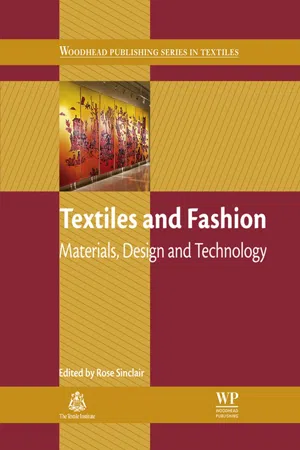1.1. Introduction
Fibres are the foundation for all textile products and can either be natural (natural fibres) or man-made (manufactured or man-made rengenerated). Within these two types or groups, there are two main kinds of fibres:
• Fibres of indefinite (very great) length, called filaments
• Fibres of much shorter length, called staple fibres
Filaments are generally combined and twisted to form yarns, whilst staple fibres are spun to create yarns. Yarns are then typically woven or knitted into fabrics. A piece of a fabric contains a huge number of fibres. For example, a small piece of lightweight fabric may contain over 100 million fibres (Morton & Hearle, 2001). Individual types of fibres can be used on their own or combined with other types of fibres to enhance the quality of the end-product. The process for combining fibres is known as blending. There are many well-known blended fibres on the market, such as Viyella, which is made of a blend of cotton and wool (Corbman, 1983).
A fibre is defined as a small threadlike structure (Hearle, 2009). The American Society for Testing and Materials (ASTM) defines a ‘fibre’ (spelt ‘fiber’ in countries using American English) as ‘a generic term for any one of the various types of matter that form the basic element of a textile, and it is characterised by having a length at least 100 times its diameter’ (Anonymous, 2001). The Textile Institute defines a fibre as a ‘textile raw material, generally characterised by flexibility, fineness and high ratio of length to thickness’ (Anonymous, 2002). A similar industry definition is a ‘unit matter with a length at least 100 times its diameter, a structure of long chain molecules having a definite preferred orientation, a diameter of 10–200 microns (micrometres), and flexibility’ (Landi, 1998). All fibres have a molecular structure that contributes to their specific attributes and properties.
The common characteristics of fibres from these definitions are:
• The diameter of a fibre is small relative to its length
• Properties of ‘flexibility’ and ‘fineness’ (a way of describing the thickness of a fibre)
It is these key characteristics and qualities that make it possible to manipulate fibres to create the much larger structures that we are familiar with such as yarns and fabrics (Wilson, 2001). Key characteristics, such as fineness and flexibility, as well as length and diameter, have a profound effect on the properties of any textile product. Many of today’s textile products are made up of blends or mixtures of different types of fibres which give a particular mix of properties that best fit how the product will ultimately be used. There are several reasons why different fibres may be blended or mixed (Bunsell, 2009; Erberle, 2004):
• To compensate for weaker attributes or properties of one type of fibre
• To improve the performance of the resulting yarn or fabric
• To improve or provide a different appearance
• To improve the efficiency of processing, especially of spinning, weaving and knitting
The advantages and disadvantages of blending and mixing fibres are discussed in Part 1 and Part 2 of this book, and include environmental issues such as recycling blended yarns (Fletcher, 2008).
1.2. Types of Textile Fibres
Textile production up until the seventeenth century was predominantly a specialised domestic production system (cottage industry) mainly done by women (Gordon, 2011). The key fibres used were wool, cotton, silk, hemp and flax (for linen). The advent of the Industrial Revolution meant mechanisation of the production process, allowing new and much faster methods of manufacturing to emerge. Over the next 300 years, it would be both developments in processing and advances in engineered fibres that would change the textile landscape. Whilst the first man-made or manufactured fibres, namely regenerated cellulose fibres, were developed in the late nineteenth century, industrial production of these fibres only really started in the early twentieth century. Synthetic fibres were developed in the late 1930s and production took off after the Second World War. The quest in the 21st century is now to create fibres that are both functional and sustainable, along with smart fibres that can be adapted precisely...
